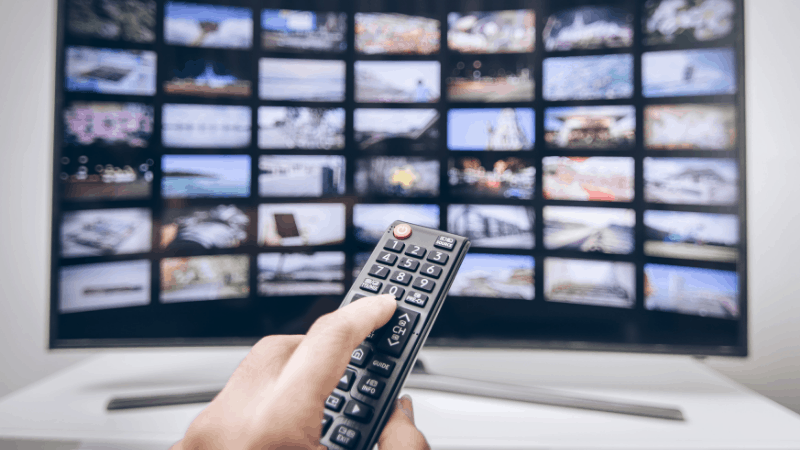How Many Amps Does a Smart TV Use?
By Trae Jacobs,
When you buy through our links, we may earn an affiliate commission.
As far as power consumption goes, smart TVs are pretty efficient. On average, a smart TV is four times more efficient than a water heater. Plasma TVs are notorious power-gobbling machines, while LCDs are less so, and LEDs the most efficient overall. With that said, you may be wondering how many amps a smart TV typically uses.
The average smart TV uses 1.0 amps per hour, which is converted to kilowatts per hour (kWh) when the power company calculates your bill for the month. 60” smart TVs may run a little higher, or surprisingly lower, depending on the efficiency rating, technology, and screen design.
In this article, we’ll cover how you can calculate the amperage your smart TV uses, as well as compare which TVs use the least amount of amps.
How to Calculate Amps Your Smart TV Uses
If you want to calculate the amperes your TV consumes every hour, you’ll have to convert watts to amps, since a smart TV’s power consumption is labeled on the back, in wattage. After that, divide the wattage 1,000, and you’ll get the number of kWh you’re consuming.
If you want to convert watts to amps, you’ll want to use the power formula, I = P / E. In this formula, P stands for watts, I stands for amps, and E stands for volts.
Which Smart TVs Consume the Fewest Amps?
Plasma TVs started to phase out in 2016, with LCDs and LEDs pushing to the forefront. Currently, the most energy-efficient of the three, LEDs are becoming the standard. However, comparing specs between LCDs and LEDs doesn’t always come down to screen technology. There are other factors involved, including processors and your TV settings.
As an example, we’ll compare two Samsung smart TVs with the same screen size and two different screen technologies:
- Samsung TU-8,000 UHD LCD 4k Smart TV: The normal operating power consumption for the TU-8,000 is 116W. At maximum capacity, that number jumps to 195W.
- Samsung 65″ Class Q90T QLED 4K Smart TV: The Q90T consumes 120W under normal circumstances, but at maximum, can run up to 295W, well beyond the TU-8,000.
If you want to find the amps that these two TVs consume, use the power formula. We know that normally the TU-8,000 operates at 116 watts, and the standard power outlet is 120V. So, Amps = 116/120. Rounded up, your ampere would be .97. At maximum—195W, your ampere would be 1.63 by dividing 120 into 195.
For the Q90T, your amp would be exactly 1, while at maximum, it would be 2.46. That’s a pretty significant jump that you can see in the settings.
All you need to know is the wattage amount found on the back of your smart TV and the knowledge that power outlets are generally 120V. (There are other power outlets in America, where the voltage is higher, but you’ll recognize them by shape, and you won’t be able to plug your smart TV into them.)
Reducing Your Smart TV’s Energy Consumption
Because of the variety of settings available with smart TVs, there’s always going to be a significant fluctuation in power consumption, depending on your choices. Here are some tips to help increase your energy efficiency:
- Manually reduce screen brightness. Reducing your screen’s brightness is the obvious choice. The brighter the light, the more power consumed.
- Use your smart TV’s energy efficiency setting. All smart TVs come with an energy efficiency setting—power-saving mode. Unfortunately, this setting can be aggravating since it usually means your TV will dim and brighten when you least expect it.
- Look for the Energy Star label when you purchase your smart TV. If you’re in the market for a smart TV, be sure to look for the Energy Star label. You don’t have to sacrifice quality—some of the highest-rated smart TVs have Energy Star labels—and you’ll reduce power consumption by 25%.
- Unplug your TV or turn off the power strip when not in use. Most people don’t realize that smart TVs still consume power in standby mode or when completely turned off (vampire power). When not in use, unplug it, or turn off the power strip to stop the drain.
- Adjust the contrast. Like brightness, the contrast has a detrimental effect as well. Be sure to turn it down to an acceptable level. Combined, brightness and contrast can reduce energy consumption by 20%.
Final Thoughts
While home appliances don’t usually list power consumption in terms of amperage, it’s good to know you don’t have to take out a student loan for a Ph.D. in Astrophysics. Determining amps is pretty simple, and you can do it with any household appliance, not just your smart TV.
As technology progresses, smart TVs are becoming more energy-efficient. Most of the time, your amps will end up being less than one. However, it’s still important to know the kWh is the measure that will show up on your power bill, and you can easily convert that number to amps just for fun.

